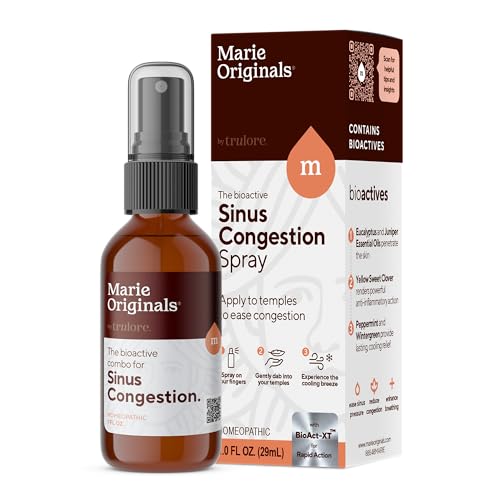
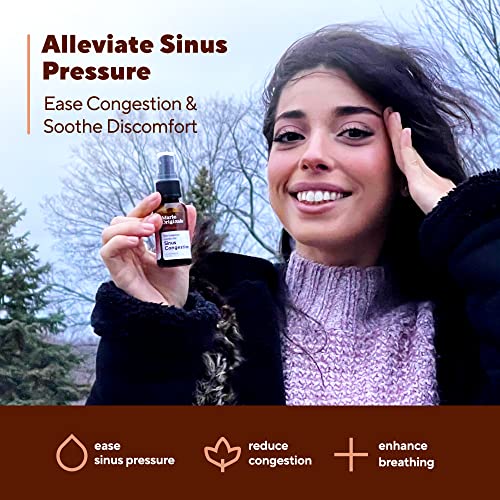

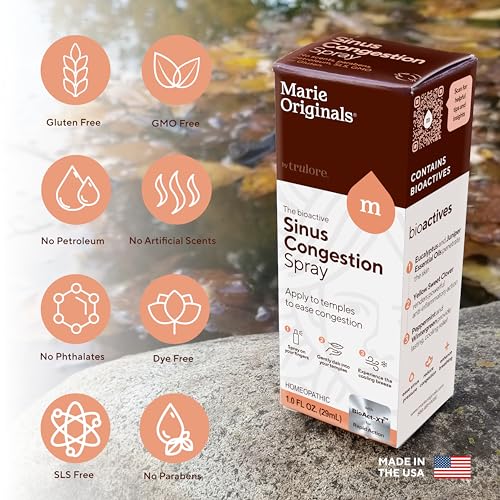
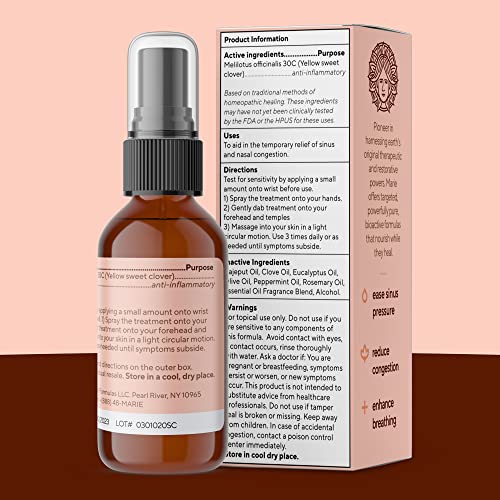
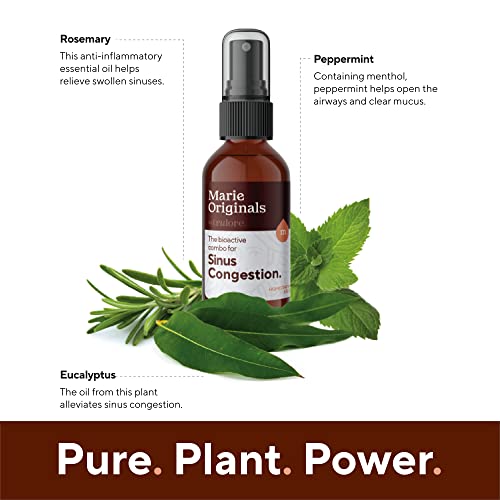
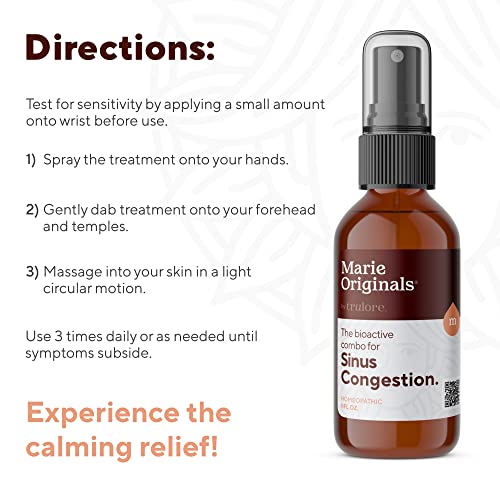
Breathe Blend Aromatherapy Sinus Spray - Instant Relief, Therapeutic Essential Oils - 2oz


Eugenia Caryophyllus (Clove) Oil
High RiskEugenia caryophyllus (clove) oil is an essential oil derived from the flower buds of the clove tree. It is primarily used for its aromatic properties and as a flavoring agent in food and beverages. Additionally, it is utilized for its potential therapeutic benefits in various cosmetic and medicinal applications.
Sustai Insights
Clove oil offers functional benefits, including antimicrobial properties and flavor enhancement, with some sustainability credentials due to its natural sourcing. However, it has a high allergenic potential and poses risks of skin irritation. Regulatory agencies advise caution in use due to these health risks. Clove oil is restricted in certain formulations, leading to an overall high-risk assessment. Safe usage practices are essential, and alternatives such as cinnamon or other essential oils may be considered.
Cajeput Oil
Medium RiskCajeput oil is an essential oil derived from the leaves and twigs of the Melaleuca cajuputi tree. It is commonly used in aromatherapy and personal care products for its aromatic properties and potential therapeutic benefits, including antiseptic and analgesic effects.
Sustai Insights
Cajeput oil offers functional benefits such as antimicrobial properties and potential relief from minor aches. It is generally considered low risk for carcinogenicity and developmental toxicity but poses moderate concerns for allergies and immunotoxicity. Environmental risks include potential pollutant status but low bioaccumulation. Regulatory bodies have not placed significant restrictions on its use. Overall, the risk level is assessed as medium, suggesting cautious use, especially for sensitive individuals. Alternatives include tea tree oil or eucalyptus oil, which may offer similar benefits with potentially lower risks.
Eucalyptus Globulus (Eucalyptus) Leaf Oil
Medium RiskEucalyptus globulus leaf oil is a volatile oil derived from the leaves of the eucalyptus tree, primarily used for its aromatic properties and as a potential antimicrobial agent in various products.
Sustai Insights
Eucalyptus globulus leaf oil offers functional benefits like fragrance and potential antimicrobial properties, supporting product efficacy. However, it presents high allergenic potential and moderate irritation concerns, which may pose health risks. Environmental risks include possible pollution and bioaccumulation. Regulatory restrictions are in place regarding its use in certain products. Overall, the risk level is medium, necessitating caution in usage and consideration of alternatives like tea tree oil or peppermint oil.
Rosmarinus Officinalis (Rosemary) Leaf Oil
Medium RiskRosmarinus officinalis (rosemary) leaf oil is extracted from the leaves of the rosemary plant. It is commonly used in cosmetic and personal care products for its aromatic properties and potential preservative benefits due to its antioxidant content.
Sustai Insights
Rosemary leaf oil offers functional benefits such as antimicrobial and antioxidant properties, which can enhance product stability. It is derived from a renewable source and is biodegradable. However, it presents moderate risks of allergic reactions and skin irritation, particularly with enhanced skin absorption. Regulatory bodies have noted restrictions on its usage in specific concentrations. The overall risk level is assessed as medium. Users are advised to follow safe usage practices and may consider alternatives like tocopherols or other natural preservatives.
Mentha Piperita (Peppermint) Oil Extract
Low RiskMentha piperita (peppermint) oil extract is derived from the peppermint plant and is commonly used in various products for its aromatic and flavoring properties. It serves multiple functions, including acting as a fragrance agent and providing a cooling sensation in topical applications.
Sustai Insights
Mentha piperita oil offers functional benefits such as flavor enhancement and a refreshing aroma, while it is generally recognized as low risk for health concerns, including carcinogenicity and allergies. Environmentally, it does not contribute significantly to pollution or bioaccumulation. Regulatory bodies do not impose restrictions on its use. Safe usage practices include avoiding excessive exposure, particularly for sensitive individuals. Alternatives like spearmint oil may be considered, but overall, this ingredient is assessed as low risk.
Olea Europaea (Olive) Oil
Low RiskOlea europaea (olive) oil is derived from the ripe fruit of the olive tree. It is commonly used in cosmetic formulations primarily as a moisturizer and emollient due to its nourishing properties for the skin. It also serves as a carrier oil for other ingredients in formulations.
Sustai Insights
Olea europaea (olive) oil offers numerous functional benefits, including effective moisturization and enhanced skin absorption properties, making it suitable for various cosmetic applications. It is a biodegradable ingredient, contributing to sustainability when sourced responsibly. Health risks are low, with minimal concerns regarding carcinogenicity, allergenic potential, and developmental toxicity. Environmental risks are also low, with no significant bioaccumulation or pollution potential noted. Regulatory bodies do not impose restrictions on its use. Overall, olive oil presents a low risk profile, making it a favorable choice in cosmetic products.
Mentha Piperita (Peppermint) Oil Extract
Low RiskMentha piperita (peppermint) oil extract is derived from the peppermint plant and is commonly used in various products for its aromatic and flavoring properties. It serves multiple functions, including acting as a fragrance agent and providing a cooling sensation in topical applications.
Sustai Insights
Mentha piperita oil offers functional benefits such as flavor enhancement and a refreshing aroma, while it is generally recognized as low risk for health concerns, including carcinogenicity and allergies. Environmentally, it does not contribute significantly to pollution or bioaccumulation. Regulatory bodies do not impose restrictions on its use. Safe usage practices include avoiding excessive exposure, particularly for sensitive individuals. Alternatives like spearmint oil may be considered, but overall, this ingredient is assessed as low risk.
Olea Europaea (Olive) Oil
Low RiskOlea europaea (olive) oil is derived from the ripe fruit of the olive tree. It is commonly used in cosmetic formulations primarily as a moisturizer and emollient due to its nourishing properties for the skin. It also serves as a carrier oil for other ingredients in formulations.
Sustai Insights
Olea europaea (olive) oil offers numerous functional benefits, including effective moisturization and enhanced skin absorption properties, making it suitable for various cosmetic applications. It is a biodegradable ingredient, contributing to sustainability when sourced responsibly. Health risks are low, with minimal concerns regarding carcinogenicity, allergenic potential, and developmental toxicity. Environmental risks are also low, with no significant bioaccumulation or pollution potential noted. Regulatory bodies do not impose restrictions on its use. Overall, olive oil presents a low risk profile, making it a favorable choice in cosmetic products.
Cajeput Oil
Medium RiskCajeput oil is an essential oil derived from the leaves and twigs of the Melaleuca cajuputi tree. It is commonly used in aromatherapy and personal care products for its aromatic properties and potential therapeutic benefits, including antiseptic and analgesic effects.
Sustai Insights
Cajeput oil offers functional benefits such as antimicrobial properties and potential relief from minor aches. It is generally considered low risk for carcinogenicity and developmental toxicity but poses moderate concerns for allergies and immunotoxicity. Environmental risks include potential pollutant status but low bioaccumulation. Regulatory bodies have not placed significant restrictions on its use. Overall, the risk level is assessed as medium, suggesting cautious use, especially for sensitive individuals. Alternatives include tea tree oil or eucalyptus oil, which may offer similar benefits with potentially lower risks.
Eugenia Caryophyllus (Clove) Oil
High RiskEugenia caryophyllus (clove) oil is an essential oil derived from the flower buds of the clove tree. It is primarily used for its aromatic properties and as a flavoring agent in food and beverages. Additionally, it is utilized for its potential therapeutic benefits in various cosmetic and medicinal applications.
Sustai Insights
Clove oil offers functional benefits, including antimicrobial properties and flavor enhancement, with some sustainability credentials due to its natural sourcing. However, it has a high allergenic potential and poses risks of skin irritation. Regulatory agencies advise caution in use due to these health risks. Clove oil is restricted in certain formulations, leading to an overall high-risk assessment. Safe usage practices are essential, and alternatives such as cinnamon or other essential oils may be considered.
Eucalyptus Globulus (Eucalyptus) Leaf Oil
Medium RiskEucalyptus globulus leaf oil is a volatile oil derived from the leaves of the eucalyptus tree, primarily used for its aromatic properties and as a potential antimicrobial agent in various products.
Sustai Insights
Eucalyptus globulus leaf oil offers functional benefits like fragrance and potential antimicrobial properties, supporting product efficacy. However, it presents high allergenic potential and moderate irritation concerns, which may pose health risks. Environmental risks include possible pollution and bioaccumulation. Regulatory restrictions are in place regarding its use in certain products. Overall, the risk level is medium, necessitating caution in usage and consideration of alternatives like tea tree oil or peppermint oil.
Rosmarinus Officinalis (Rosemary) Leaf Oil
Medium RiskRosmarinus officinalis (rosemary) leaf oil is extracted from the leaves of the rosemary plant. It is commonly used in cosmetic and personal care products for its aromatic properties and potential preservative benefits due to its antioxidant content.
Sustai Insights
Rosemary leaf oil offers functional benefits such as antimicrobial and antioxidant properties, which can enhance product stability. It is derived from a renewable source and is biodegradable. However, it presents moderate risks of allergic reactions and skin irritation, particularly with enhanced skin absorption. Regulatory bodies have noted restrictions on its usage in specific concentrations. The overall risk level is assessed as medium. Users are advised to follow safe usage practices and may consider alternatives like tocopherols or other natural preservatives.
Discover the soothing power of the Breathe Blend Essential Oil Sinus Spray, expertly crafted to relieve sinus pressure and promote relaxation. This all-natural remedy combines therapeutic essential oils like peppermint, eucalyptus, and rosemary to enhance your breathing and improve sleep quality.
- Soothing Relief: Experience immediate comfort with just a few sprays, designed to ease congestion and sinus discomfort.
- Natural Ingredients: Made with premium essential oils, free from harsh chemicals, parabens, and artificial additives, ensuring a safe and pure experience.
- Convenient Use: Simple to apply—shake, spray, and breathe deeply for instant relief. Perfect for daily use or when you need a quick pick-me-up.
- Versatile Benefits: Not just for congestion, this spray helps reduce stress and promotes better sleep, making it a must-have for holistic wellness.
- Eco-Friendly Choice: Committed to sustainability, this product supports your health and the environment with ethically sourced ingredients and eco-conscious practices.
Subscribe & Save with Sustai
- Best Price Guarantee: Always enjoy the lowest prices on sustainable home essentials.
- No Surprises: We’ll notify you before shipping. No hidden fees, ever.
- You’re in Charge: Change, pause, or cancel your subscription anytime with ease.
- Eco-Friendly Deliveries: Our grouped shipments mean less packaging and lower emissions.
Join us on a sustainable journey. Special offers for a limited time! Prices and promotions may change.
Recommended Products
Discover the soothing power of the Breathe Blend Essential Oil Sinus Spray, expertly crafted to relieve sinus pressure and promote relaxation. This all-natural remedy combines therapeutic essential oils like peppermint, eucalyptus, and rosemary to enhance your breathing and improve sleep quality.
- Soothing Relief: Experience immediate comfort with just a few sprays, designed to ease congestion and sinus discomfort.
- Natural Ingredients: Made with premium essential oils, free from harsh chemicals, parabens, and artificial additives, ensuring a safe and pure experience.
- Convenient Use: Simple to apply—shake, spray, and breathe deeply for instant relief. Perfect for daily use or when you need a quick pick-me-up.
- Versatile Benefits: Not just for congestion, this spray helps reduce stress and promotes better sleep, making it a must-have for holistic wellness.
- Eco-Friendly Choice: Committed to sustainability, this product supports your health and the environment with ethically sourced ingredients and eco-conscious practices.

You can have at most 2 Sustainable Steals products in your cart
Customer Reviews
Customers’ View
Customers appreciate the effectiveness and natural formulation of this essential oil sinus spray, often highlighting its immediate relief from sinus pressure and congestion. Many users report significant improvements in their ability to breathe freely, with one customer stating it provided 'immediate relief' during severe asthma flare-ups. The pleasant aroma of the spray is frequently praised, contributing to a calming atmosphere. Additionally, the product's all-natural ingredients resonate well with health-conscious consumers, as it is free from harsh chemicals. Overall, customers find this sinus spray to be a valuable addition to their wellness routine, particularly for those seeking eco-friendly and effective solutions.
AI-generated from the text of customer reviewsThis product is rated 4.5 of 5.0 stars.
It has received 4 reviews.




